Raghly Lodge
Houses within 15km of this house
Displaying 72 houses.
Houses within 15km of Raghly Lodge
Displaying 72 houses.
| House name | Description | |
|---|---|---|
| Seafield or Lisheen | At the time of Griffiths Valuation, William Phibbs owned a house at Lisheenacooravan valued at £55. This house was known as Seafield or Lisheen at different times. In 1906 Seafield/Lisheen was valued at £55. The property is now a ruin |

|
| Lissadell or Lissadill | The Gore Booth family built the first Lissadell House between 1750-1760, in front of the current house. The current house was built in the late eighteenth and early nineteenth century and continued to be the home of the Gore Booth family until the 1990s. In 1906 the house and buildings were valued at £347. The house has been open to the public for many years. It is now owned by E. Walsh and C. Cassidy and is being restored. See www.lissadellhouse.com. |

|
| Streedagh | It is likely that Thomas Jones built a house at Streedagh c 1725. However, the present house dates from the early years of the nineteenth century. In 1906 it was the property of Richard W. Jones and was valued at £18. It is still extant and occupied. |

|
| Moneygold | At the time of Griffith's Valuation, Moneygold was leased by the Fawcett family from Viscount Palmerston's estate and was valued at £13. Lewis records it as the residence of the Soden family in 1837. McTernan notes that it was the seat of the family from the early eighteenth century when James Soden leased almost 1000 acres from the Temple estate. In 1906 it was the property of Major G.M. Eccles whose mother was Isabella Soden. The house was damaged in a storm in the early 1960s and subsequently demolished. | |
| Ellenville or Ardaghowen | The first edition OS Map suggests the house on this site was known at that time as Ellenville. It is now known as Ardaghown, still extant but derelict and was under renovation in 2006. McTernan indicates that it was originally built as a dower house for the Wynne estate. In the 1850s it was held by Owen Wynne from Capt. James Martin and valued at £35. |

|
| Doonally | The Parke family were granted lands at Doonally (or Dunally) in the 17th century. These lands had previously belonged to the O'Connors. The building currently at this site was built c.1830. It was the property of Roger Parke at the time of Griffiths Valuation and was valued at £40. In 1906 it was valued at £44. In the mid-twentieth century it was sold to the North West Cattle Breeders Association and used as an administrative headquarters. It is now vacant but rapidly becoming derelict. |

|
| Culleenamore | At the time of Griffith's Valuation, Samuel Barrett was leasing the house at Culleenamore, barony of Carbury, from Edward Nicholson, when it was valued at £16. | |
| Grange/Primrose Grange | Richard Gethin was leasing a house at Primrose Grange to Christopher Allen at the time of Griffith's Valuation when it was valued at £14. McTernan notes this as Grange House, built in the eighteenth century and enlarged c.1820. It was leased to a succession of families thoroughout the nineteenth and twentieth centuries and was eventually demolished in 1981. A building formerly used as a school is stil extant and lived in. |

|
| Cummeen (also spelt Cummin) | The Ormsby family had a house at Cummeen, Coolera in the eighteenth century. Wilson noted it as the residence of John Ormsby in 1786, when he describes it as "a magniificent and beautiful seat". At the time of Griffith's Valuation the representatives of Charles Ormsby were leasing the house and land at Cumeen to William Phibbs who in turn leased the house to Alexander Wylie. It was valued at £13. Some building remains and a possible folly are still visible at the site. |

|
| Rathcarrick | At the time of Griffith's Valuation there were two substantial houses at Rathcarrick, barony of Carbury, both belonging to the Walker estate. John McHutcheon was leasing one property valued at £18 while Amy Eliza Walker was leasing the second, valued at £28. In 1906 John F. Walker was the owner of a house at Rathcarrick, then valued at £63. Rathcarrick house is still extant and has recently been renovated. |

|
| Cloverhill | Cloverhill was part of the Earl of Erne's estate in county Sligo. At the time of Griffith's Valuation, it was leased to William C. Chambers when it was valued at £28. In 1786 Wilson had noted it as a seat of "Mr. Chalmers" so it had been occupied by that family since the eighteenth century. Cloverhill House was demolished in 1988. Some remains of estate walls visible. | |
| Breeogue | Matthew Walsh was leasing this property from the Earl of Erne's estate at the time of Griffith's Valuation when it was valued at almost £6. Breeogue House is still extant and occupied. |

|
| Kevinsfort | Kevinsfort House was built c.1820. It was the home of various other families at different times in the 19th century, including Capt. George Dodwell. At the time of Griffith's Valuation it seems to have been leased by Alexander Popham to John Stoll and valued at £52. McTernan notes that Popham was Dodwell's son-in-law. The property was sold by the Pophams in 1923. Kevinsfort is still extant and occupied. |

|
| Cleveragh | Capt. James Martin was the lessor of a property valued at £18 at Cleaveragh Demesne, barony of Carbury at the time of Griffith's Valuation. It was being leased by Robert Wilson. It continued in Martin ownership until the twentieth century though frequently occupied by tenants. The house and demesne were eventually bought by Sligo Borough Council with the intention of creating a town park though this was only partially realised. The house was demolished in 1999. | |
| Woodville | Woodville House is still extant and occupied by the Wood family who operate an open farm there. At the time of Griffith's Valuation, it was being leased by Alicia Martin from Capt. James Wood and was valued at £42. |
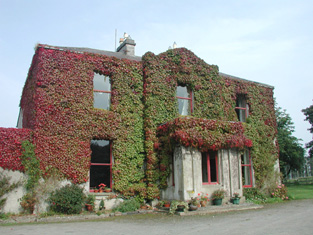
|
| Mount Temple | Viscount Palmerston was leasing a property valued at £3 15s to Edward Parke in this townland at the time of Griffith's Valuation. It is estimated that the house now at Mount Temple was built c.1860. McTernan notes that the property was originally part of the Soden estate but was leased to the Parkes in the 1830s. They were to continue in occupation until the 1940s after which Mount Temple was acquired by the Land Commission. The house is still extant but derelict. |

|
| Longford House | Longford House was built in the mid-18th century but was destroyed in a fire in the early 19th century,c1816. It is this house to which Wilson refers as the seat of Mr. Crofton in 1786. Another house was built adjacent to the original. McTernan notes that this house also suffered fire damage in both 1840 and again in 1916. At the time of Griffith's Valuation a house at Longford Demesne was valued at £13 and was the property of Sir Malby Crofton. In 1906 this was the property of Sir Malby Crofton and was valued at £30. The later Longford House is still extant and occupied. The original is an impressive ruin. |

|
| Port Royal | At the time of Griffith's Valuation, Henry Griffith was leasing a property at Buninna, including a mill from the Cooper estate. The property was valued at £12. McTernan notes that this house is described in early nineteenth century documents as a "marine villa". It was later occupied by the McMunn and Hart families. It is stil extant but dilapidated. | |
| Tanrego | In 1786 Wilson writes that Mr. Irwin's property was situated "on the right of Strandhouse Inn" and nearby was Tanrago, the seat of Mr. Dodwell. At the time of Griffith's Valuation, Capt.Richard Olpherts was occupying a house at Tanrego, barony of Tireragh. In 1894 Slater refers to Tanregoe as the seat of Richard Verschoyle. In 1906 Tanrego was the property of Richard J. Verschoyle and was valued at £25. It is still extant and occupied. |

|
| Beltra Rectory | This house, part of the Irwin estate, was on perpetual lease from the Cooper estate. It principally functioned as the local rectory. At the time of Griffith's Valuation the property was occupied by Rev. St.George Knox and was valued at £13. |

|
| Carrowculleen House | At the time of Griffith's Valuation, Lecarrow was the property of Thomas Guilfoyle and was valued at £14. In 1906 Anthony Guilfoyle was the owner of the house at Lecarrow, valued at £31. McTernan notes that the property was purchased by Anthony Gilfoyle, a leading Sligo merchant, c.1806. It was extended in the 1840s. From the 1920s until the 1990s it was owned by the Mercy Order. The house is now part of the Holy Hill Hermitage complex. |
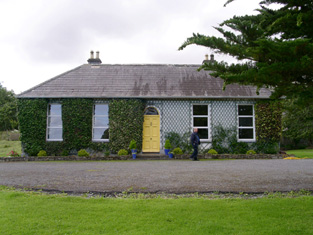
|
| Toberpatrick (Skreen) | Wilson, writing in 1786, refers to "Tubberpatrick" as the seat of Captain Jones. In 1837 Lewis recorded Tubberpatrick House as a seat of the Jones family. At the time of the estate sale in the Encumbered Estates court in April 1852, the house at Tubberpatrick was described as "a dwelling house fit for the reception of a gentleman, with offices and garden on the demesne". At the time of Griffith's Valuation it was the property of Peter O'Connor and was valued at £15. Toberpatrick House is still extant and occupied. In 2008 it was offered for sale through Knight Frank estate agents [Irish Times, 13 March 2008]. |

|
| Leekfield | Leekfield was originally a Wood property which came into the Webb family through the marriage of Sarah Wood to Daniel Webb Webber. It is recorded as his residence in 1814. McTernan notes that the Webber estate, including Leekfield House and demesne lands, was offered for sale by Charles Tankerville Webber in the 1890s. Leekfield was acquired by Michael Higgins, who had been the agent for the Webber estate. It was demolished in the 1960s. | |
| Seafort House | At the time of Griffith's Valuation, Richard Wood was leasing a property valued at £14 at Carrowbrickeen, barony of Tireragh, from the representatives of Arthur Cooper. Lewis records Seafort House as a residence of the Wood family in 1837. In 1814 it was the seat of Richard Wood. McTernan notes that Seafort House was demolished in the twentieth century and a modern house stands at the site. | |
| Seaview or Doonecoy | The Hillas family seem to have occupied the house at Carrowmacrory since the eighteenth century as McTernan notes that it was built by Robert Hillas who was High Sheriff of Sligo in 1772. Mrs. Esther Hillas was occupying the house, valued at £25, at the time of Griffith's Valuation. In 1906 it was the property of Robert G. Hillas and was valued at £23. The house was eventually sold in 1955 to the O'Beirne family by whom it is still owned. |

|
| Corkhill House | Sir Malby Crofton is recorded as the lessor of two properties in the parish of Templeboy at the time of Griffith's Valuation. One property is noted as a herd's house, valued at £1 while the second, valued at £1 5s, was leased to Thomas Fury. McTernan notes that in the eighteenth century this house had been leased from the Crofton estate by the Wood family. It eventually fell into disrepair and was demolished. | |
| Rathbraughan | The 1st edition OS map indicates the house at this location was known as Auburn Cottage. At the time of Griffith's Valuation it was occupied by Edward Smith {Smyth] leasing from William Green and valued at £23. McTernan writes that Smyth was the agent for Lord Palmerston's estate. At times it was leased by members of the Gethin family. It was demolished in the 1980s when Rathbraughan housing estate was built. | |
| Ardtermon Castle | Ardtermon was the first property held by the Gore family before the building of Lissadell. McTernan notes that it was granted to Sir Francis Gore and had previously been the property of the O'Hart family. The Gore Booth family moved to Lissadell in the mid eighteenth century. Since 1979 it has been the home of the Schiller family who have restored it to its former glory from total ruin. See www.ardtarmoncastle.com |

|
| The Hermitage | At the time of Griffith's Valuation, Harper Campbell was leasing a property at The Mall, Sligo, valued at £41. It had been purchased by him in the Encumbered Estates Court in 1855, having previously been the property of a member of the Wynne family. McTernan notes that it was destroyed by fire in 1976 and the site is now occupied by educational buildings. | |
| Carrowgarry | In 1906 Alexander Crichton was the owner of Carrowgarry House, valued at £37. At the time of Griffith's Valuation, a herd's house, valued at £3 and part of the Crichton estate, was located here. |

|
| Doonaleragh Lodge | This house was built as a summer house for the family residing at Rathcarrick. At the time of Griffith's Valuation, Amy Eliza Walker was leasing it and over 300 acres from the representatives of Roger Walker. It was valued at £10. It is still extant and occupied. |

|
| Dirk Lodge | Alexander Crichton's address is given as Dirk Lodge, Drumard, in 1870s Landowners Listings. In the 1850s the house is described as a "steward's house" valued at £8. In 1906 he was the owner of a house valued at £8 at Derk Beg, barony of Tireragh. McTernan notes that this property had been a herd's house in the early ineteenth century but was enlarged in the 1880s. It is still extant and occupied. |
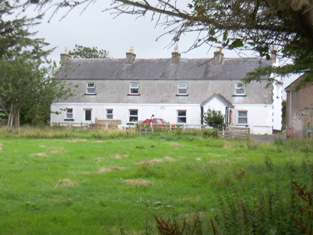
|
| Glen Lodge | Around 1780 James Sandford Nicholson settled in the newly built family seat which he named Glen Lodge. It was in the possession of Thomas White at the time of Griffith's Valuation who was leasing it to James Coghrane when it was valued at £15. At the time the estate was sold in the Landed Estates Court in 1876 Glen Lodge is described as "a good residence, leased by the Court of Chancery to Andrew James for 7 years from 1869". The house is still extant and occupied. |

|
| Finned House | In 1906 Sir Jocelyn Gore Booth owned buildings valued at £8 at Finned, barony of Carbury. This is likely to be Finned House. This townland was the property of the Gore Booth estate at the time of Griffith's Valuation but the highest building valuation at that time was only £2. | |
| Ballygilgan Gate Lodge | In 1906 Sir Jocelyn Gore Booth held over 800 acres of untenanted land at Ballygilgan as well as a house valued at almost £9. |
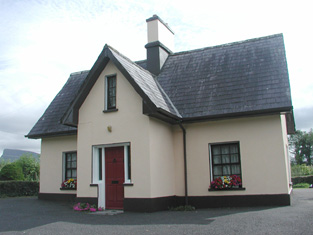
|
| Elsinore | At the time of Griffith's Valuation, Edward Cooper owned a property at Rosses Upper, barony of Carbury, valued at £16. In 1906 the representatives of William Middleton held a property here valued at £18 as well as over 350 acres of untenanted land. The property also has associations with W.B. Yeats who used to spend holidays here with the Middleton family. The house is now a ruin. |

|
| Ballygreighen | In 1906 Henry E. King owned over 350 acres of untenanted land and buildings valued at £10, at Ballygreighen, barony of Tireragh. At the time of Griffith's Valuation Andrew Finnegan was leasing a property valued at £8 from the King estate at Ballygreighen. The original buildings is no longer extant. | |
| Willowbrook | At the time of Griffith's Valuation, Andrew McCullough was leasing a property at Willowbrook, valued at £13, from Mrs. Ormsby Gore. In 1906 Lord Harlech's estate owned property valued at £3 at Willowbrook, barony of Carbury. McTernan notes that the house was accidentaly destroyed by fire in December 1867. The ruin is still visible. | |
| Wynnesfort House | In 1906 Alexander Lyons owned a property valued at £8 at Rahaberna, barony of Carbury. At the time of Griffith's Valuation this property was leased from the Lyons estate by George Robinson. McTernan states that the lands passed from the Knox to the Wynne estate in the late eighteenth century. In the early nineteenth century William C. Wood of Rathellen had possession and the house was let to a succession of tenants. It was sold in the Encumbered Estates court in 1853 when the purchaser was Henry Lyons. | |
| Mount Shannon | At the time of Griffith's Valuation, Francis Olpherts was leasing Mount Shannon, barony of Carbury from John Wynne. The house was then valued at £35. McTernan states that Olpherts had recently been appointed agent to the Wynne estate and later married Marianna Wynne of Ardaghowen. The house is still recorded by Slater as being in his possession in 1894. It has had a number of owners since the early twentieth century but is still extant and occupied. |
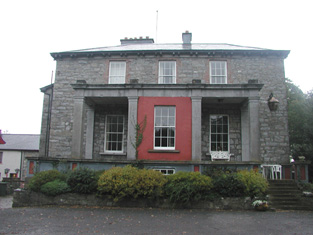
|
| Cregg House | Michael Jones, formerly of Lisgoole, county Fermanagh, is described as of Cregg House in 1854. His representatives still held the property in the 1870s. At the time of Griffith's Valuation, it was occupied by Capt. Alex Lumsden, son-in-law of Michael Jones, leasing from John Wynne, when it was valued at £25. Cregg House afterwards came into the possession of the Sisters of La Sagesse and is now a Special Needs facility. |
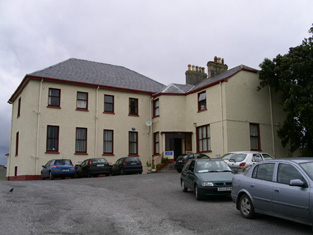
|
| Faughts Cottage | At the time of Griffith's Valuation, Phillip Parke was leasing a property at Faughts, barony of Carbury, valued at £7, from John Wynne. This appears to be the house described on both the First and 25-inch edition Ordnance Survey maps as "Faughts Cottage". A house is still extant at the site. | |
| Castlegal House | At the time of Griffith's Valuation George Dunne was leasing two properties in the townland of Castlegal to the Parke family. John Parke was renting a house valued at £7 together with 50 acres while Phillip Parke was leasing a house valued at £5 and 98 acres. McTernan states that prior to being owned by the Dunn family this property belonged to the Cope estate. Castelgal is still extant and occupied. | |
| Castle Lodge | At the time of Griffith's Valuation, Richard Beatty was leasing a property valued at £6 from the Fury estate at Ballinphull, barony of Tireragh. McTernan notes that the Fury/Furey family owned this property up to the end of the nineteenth century but did not live there. The Ordnance Survey Field Name Books refer to Castle Lodge as "a handsome cottage in good repair". The house was burned during the Civil War but subsequently repaired. It is still extant but in disrepair. | |
| Rahelly | Francis Barber was leasing a house at Rahelly, barony of Carbury, from the Gore Booth estate at the time of Griffith's Valuation, when it was valued at £25. Rahelly later fell into ruin but has been restored and offered for sale in recent times. |

|
| Millbrook House(Drumcliff) | Edward Simpson was leasing a house, mill and associated buildings at Ballincar, barony of Carbury valued at £16 from the Wynne estate at the time of Griffith's Valuation. He offered the property for sale in the Landed Estate's Court in April 1873. The sale notice indicates that he held it on a Fee Farm Grant from Owen Wynne dated 1868. The original house is no longer extant. | |
| Mount Edward Cottage | Both the Ordnance Survey Field Name Books and Griffith's Valuation record a property at Mount Edward as belonging to Capt. James Jones. It had a valuation of £2 in the 1850s. This would appear to be the property named as Mount Edward Cottage on the 1st edition OS map. McTernan states that it was occupied by the Hood family from the mid-nineteenth century until the 1980s. It is now in a dilapidated state. | |
| AbbeyView | At the time of Griffith's Valuation, Alexander Phillips was leasing a house valued at almost £14 at Abbeyquarter North, barony of Carbury, from the Cooper estate. McTernan states that it was built in the later eighteenth century and described in 1878 "as a beautifully situated villa residence with attractive grounds". The Phillips family continued in residence until the 1860s after which it was occupied by a succession of owners until the 1990s when it was sold to the Electricity Supply Board who demolished the house. | |
| Oxfield | At the time of Griffith's Valuation, Oxfield House was the caretaker's residence for the plantation of over 150 acres owned by the Gore Booth estate at Cullaghmore, barony of Carbury. | |
| Springfield | The Phibbs estate owned several houses as well as the townland of Springfield or Magheralgillerneeve, barony of Carbury at the time of Griffith's Valuation. One house, valued at £12, was being leased by John Mullan. | |
| Tully House (Carbury) | Charles Simpson was leasing a house valued at £6 at Tully, barony of Carbury, from the Wynne estate, at the time of Griffith's Valuation. A house is still extant at the site. | |
| Highpark House | At the time of Griffith's Valuation, James Dowdican was leasing property from the Webber estate in the parish of Skreen including a house valued at £2 at Carrowgilhooly. This may be the property named as Highpark House both on the First and 25-inch editions Ordnance Survey Maps. There is still a house extant on the site. | |
| Fort Laurel | Patrick and Hugh Maguire were leasing over 60 acres from the Palmer estate at Ardogelly at the time of Griffith's Valuation. Fort Laurel House was later built at this property. It was renovated in the late twentieth century and is now a family home. |
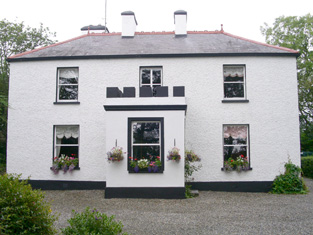
|
| Strandhill House | At the time of Griffith's Valuation George D. Meredith was leasing Strandhill House, valued at £9, from the estate of William Phibbs. McTernan states that the house remained in the Meredith family until the 1960s. It is now a roofless ruin. | |
| Rockville (Carbury) | Edward Homan was leasing two properties, both valued at over £4 and described as Bathing Lodges, at Culleenamore, from Samuel Barrett, at the time of Griffith's Valuation. One house is noted on the OS 1st edition sheet as Rockville and the second as Bocage. | |
| Lisnalurg House | George Robinson was leasing Lisnalurg House from the Wynne estate at the time of Griffith's Valuation when it was valued at £14. McTernan notes that it was sometime the accommodation of the estate agent. It is still extant and occupied by descendents of the Wynne family. | |
| Belleview Cottage | Robert Whiteside was leasing the property at Lisnalurg, known as Belleview Cottage from the Wynne estate, at the time of Griffith's Valuation. It was valued at £8. The site is now occupied by a house known as Ardeevin | |
| Summerhill (Carbury) | At the time of Griffith's Valuation, John Gowan was leasing a house valued at £6 at Lisnalurg, from the Wynne estate. This is the house known as Summerhill which, in the 1870s, was acquired by the Anderson family who remained in possession until 1922. It is still extant. | |
| Violet Hill | At the time of Griffith's Valuation Thomas McDonnell was leasing an extensive mill complex and a house at Shannon Oughter, from the Martin estate. The entire property was valued at over £30. | |
| Ballytivnan House | McTernan writes that this was a 2-storey eighteenth century residence, occupied by the Griffith family until the 1830s. Following them it was the home of Jack Taaffe and was damaged on the night of the Big Wind in January 1839. It was later occupied by the Kelly family. Afterwards acquired by the Health authorities and subsequently demolished. | |
| Cairnsfoot | McTernan indicates that Maj. De Bromhead is the reputed builder of Cairnsfoot, probably in the early decades of the nineteenth century, when he leased the lands from the Cooper estate. He had married Judith Wood in 1823. In the 1840s he returned to England and the house was let to a number of different families, notably the O'Connors. In 2004 it was partially destroyed by fire and subsequently demolished. | |
| Rathanna | Col. Knox Barrett held this property from Jane Mullin at the time of Griffith's Valuation when it was valued at £20. It remained in the Barret family until the early 1900s when it was sold to the Monahan family who owned it until the 1960s. McTernan writes that it was sold to the Jurys Hotel Group who built the Sligo Park Hotel in front of the original house which was demolished in the 1980s. | |
| Rathellen | McTernan writes that Rathellen was built at the beginning of the nineteenth century as a dower house for the Wood of Woodville estate.. It was purchased by Henry Lyons in 1860 and remained in the Lyons family until the 1940s. It is still extant but unoccupied. | |
| Rose Hill (Sligo) | McTernan writes that this was originally the residence of Thomas Reed and known as Lakeview. It passed to his son-in-law, Vernon Davys, in the early 1830s. After the 1840s it was leased to a succession of tenants. It was demolished in the 1980s to make way for modern housing. | |
| Altanelvick | A summer residence of the Jones family of Benada. In 1857 held in fee by Daniel Jones and valued at £3. The house became derelict in the twentieth century but has since been restored. | |
| Drumcliff | The townland of Drumcliff South formed part of the Gethin estate in this area in the eighteenth century. This house was leased to Charles Allen at the time of Griffith's Valuation, when it was valued at £12 10s. The house had a succession of owners in the twentieth century and is still extant and occupied. | |
| Lower Shannon House | John Duncan was leasing this property from the Wynne estate at the time of Griffith's Valuation, when it was valued at £10.McTernan notes that it was purchased by his relatives from the Wynne estate in the early twentieth century. The property was sold again in the 1920s to the Donaghy family and continues in their possession. | |
| Moorfield Cottage | Jeremiah Rogers, a steward on the Gore-Booth estate, was occupying this property at the time of Griffith's Valuation, when it was valued at £5 10s. McTernan states that it remained in the Rogers family until the early decades of the twentieth century. It is still extant and occupied. | |
| Finisklin House or Seamount | Built as a seaside residence of the Wood family though frequently leased by them to various other families. In the mid nineteenth century it was the residence of Thomas Mostyn Wood and valued at £11. In the 1870s, McTernan notes that it passed to the land agent Richard St. George Robinson, in whose family it remained until the early twentieth century. It is still extant and has been restored. | |
| Urlar or Beckfield | Leased by William Hamilton,MD, from the Gore-Booth estate at the time of Griffith's Valuaiton when it was valued at over £10. McTernan notes that it was previously held by the Munns family and later in the nineteenth century by George Somerville. Labeled as Beckfield on the First Edition Ordnance Survey Map. It is still extant and undergoing restoration. | |
| Oakfield House (Sligo) | In 1786 Wilson notes a house close to Cloverhill House as the seat of Mr. Deboots [?]. This may be Oakfield House. At the time of Griffith's Valuation, this property was leased from Captain Richard Gethin by Joseph Holmes. It is described as a herd's house and was valued at £3 10s at the time. An extensive farm is still extant at the site. | |
| Ardnaglass | Wilson, writing in 1786, refers to Ardnaglass as the seat of Mr. Jones, "half a mile beyond the ruins of a castle". The castle he refers to is Ardnaglass Castle, also associated with the Jones family. Earlier, in 1739, Reverend William Henry mentions Ardnaglass as the seat of Loftus Jones. By the time of Griffith's Valuation, this townland was part of the Webber estate, leased by William Graham. He was occupying a property valued at £4. The castle ruins are still extant. |

